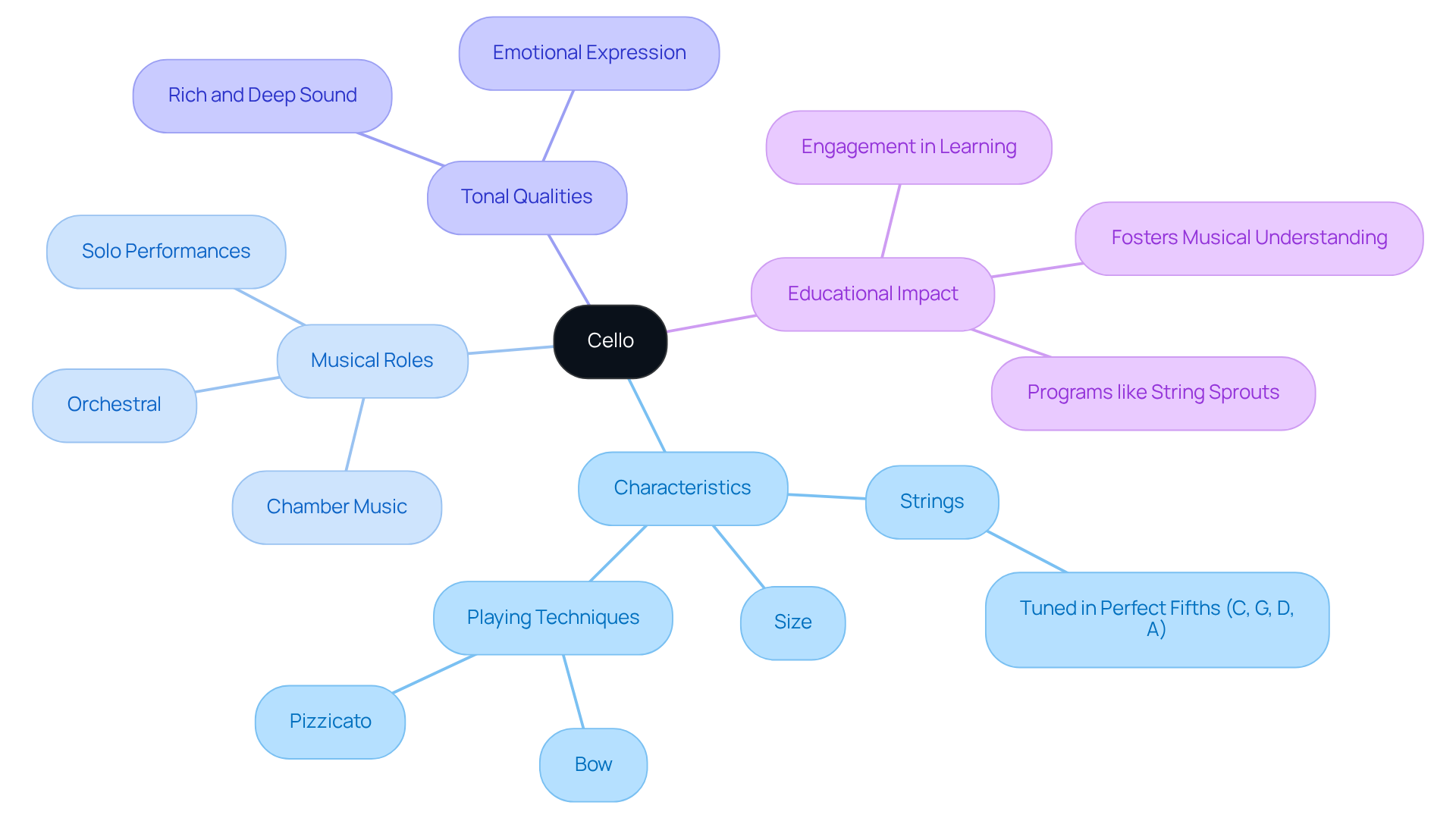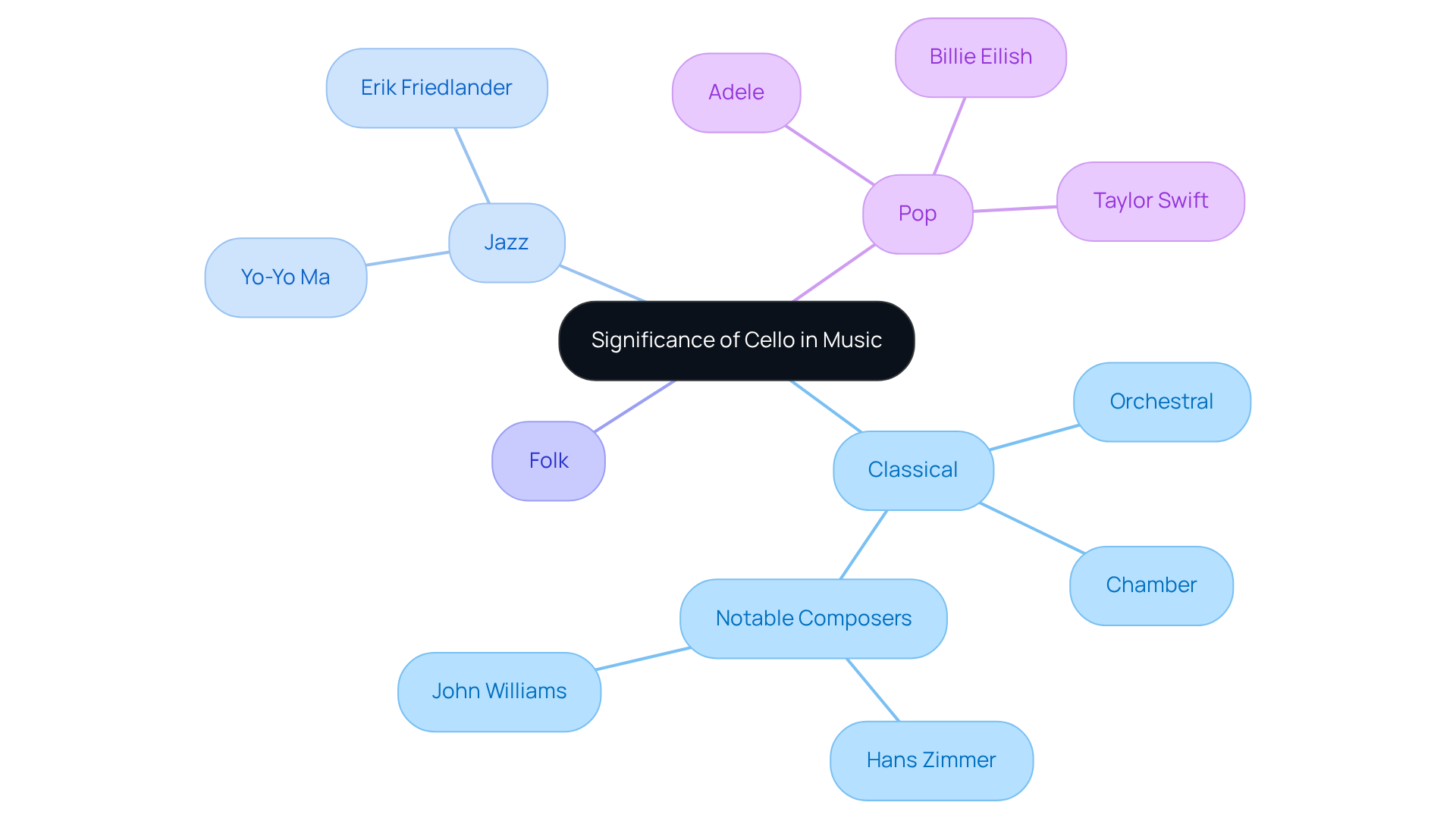Overview
The cello stands as a versatile string instrument, renowned for its rich, deep sound. This instrument plays a significant role across various musical genres, particularly within orchestras and chamber music. Its historical evolution, emotional expressiveness, and structural components are pivotal, illustrating the cello's enduring appeal and importance in both educational settings and contemporary music.
Introduction
The cello, a distinguished member of the violin family, is renowned for its rich, deep tones and remarkable versatility across musical genres. It serves as a bridge between orchestral depth and solo expression, and understanding the cello's role, history, and significance reveals a world of musical opportunity.
What makes this instrument so compelling? How has its evolution shaped its place in both classical and contemporary music? Exploring these questions uncovers the cello's profound impact on musicians and audiences alike, as well as its enduring relevance in the ever-evolving landscape of sound.
Define Cello: Understanding Its Role and Characteristics
A distinguished member of the violin family, the instrument is renowned for its rich, deep sound and remarkable versatility across diverse musical genres, prompting many to ask what is cello. Typically played in a seated position, the instrument known as the cello is larger than both the violin and viola, yet smaller than the double bass, prompting the question of what is cello. What is cello? This instrument features four strings tuned in perfect fifths (C, G, D, A) and can be performed with a bow or through pizzicato techniques. Its unique tonal qualities allow it to convey a vast array of emotions, which is why many people wonder what is cello, making it an essential component in orchestras, chamber music, and solo performances.
In orchestral settings, what is cello serves not only as a melodic entity but also as a harmonic foundation, enhancing compositions with depth and resonance. The significance of this instrument is underscored by the notable percentage of musicians who choose to play it, illustrating what is cello's appeal compared to others. As we approach 2025, it remains vital to know what is cello in both orchestral and chamber performances, contributing to the overall sound and texture of ensembles.
The influence of the instrument's tonal characteristics, particularly what is cello, extends into educational environments, where its capacity for emotional expression and complexity fosters a deeper understanding of musical concepts among learners. Case studies have shown that incorporating this instrument into educational programs boosts students' engagement and appreciation for music, further solidifying its importance in the learning experience. As educators recognize the instrument's unique attributes, they increasingly advocate for its inclusion in curricula to teach students what is cello, ensuring that future generations can experience its profound musicality.

Trace the History of Cello: From Origins to Modern Usage
The origins of the stringed musical device can be traced back to the early 16th century in Italy, evolving from earlier string creations such as the viola da gamba. Initially, it was utilized mainly in orchestral contexts and served as a continuo element in Baroque music. The stringed device rose to prominence during the Classical era, with composers such as Haydn and Beethoven creating significant pieces for it. The Romantic period further reinforced the instrument's status, as composers like Dvořák and Elgar highlighted its expressive capabilities. Today, this string instrument stands as a prominent tool across various genres, including classical, jazz, and contemporary music, reflecting its adaptability and enduring appeal.

Examine Cello Components: Anatomy and Functionality
The string instrument comprises various crucial elements, each playing a significant role in its performance and audio quality. The structure, crafted from premium wood, serves as a resonating chamber that enhances the tones produced by the strings. This amplification is vital for achieving the instrument's rich tonal qualities. The neck, fingerboard, and bridge are essential for playability, empowering musicians to produce a wide range of pitches and tones with precision.
Strings, typically made from gut, steel, or synthetic materials, are fundamental to understanding what is cello's unique tone. The choice of string material can significantly influence the instrument's tonal characteristics and responsiveness. The bow, constructed from horsehair and wood, is critical for generating tones, as it creates vibrations by drawing across the strings.
The quality and skill involved in each component are indispensable; meticulous attention to detail in the assembly of the instrument directly impacts its overall tone and performance. Luthiers emphasize that superior craftsmanship not only enhances the aesthetic appeal of the instrument but also ensures optimal resonance and tonal clarity. Furthermore, understanding the typical lifespan of string instrument parts and their maintenance is crucial for preserving the instrument's integrity and audio quality over time.
In conclusion, one must consider what is cello, as the structure of the instrument—including its body, neck, strings, and bow—plays a pivotal role in its functionality and sound production, highlighting the importance of high-quality craftsmanship in achieving exceptional musical performance.

Explore Cello's Significance in Music: Genres and Influence
The instrument's significance in music spans a wide array of genres, including classical, jazz, folk, and pop. In classical settings, it serves not only as a solo instrument but also as a crucial component of orchestral and chamber ensembles. Its emotive qualities have made it a favored choice for film scores, enhancing the emotional depth of cinematic storytelling. Notable composers such as Hans Zimmer and John Williams have utilized its haunting tone to evoke powerful emotions in their scores, demonstrating its impact on contemporary film music. John Williams remarked on the instrument's ability to evoke feelings, further highlighting its contribution to crafting memorable moments in film.
In the jazz realm, the instrument has carved out a distinctive voice, with artists such as Yo-Yo Ma and Erik Friedlander redefining its traditional role. These artists combine classical methods with jazz spontaneity, showcasing its versatility and broadening its role in modern compositions. The instrument's ability to bridge genres and resonate with diverse audiences underscores its enduring appeal.
The incorporation of the instrument into contemporary genres has also gained momentum, with mainstream artists like Adele, Billie Eilish, and Taylor Swift frequently including its warm sound in their arrangements. This trend not only expands its audience but also emphasizes its versatility across various musical styles. Recent statistics indicate that the instrument's presence in popular genres is increasing, highlighting its significance in the current sonic landscape. As the cello continues to thrive in various genres, it remains a powerful and relevant instrument in the ever-evolving landscape of music.

Conclusion
The cello stands as a remarkable instrument within the violin family, celebrated for its deep, resonant sound and versatility across numerous musical styles. Its role transcends mere performance; it serves as both a melodic and harmonic foundation in orchestras and chamber music, enriching the overall musical experience. Understanding the cello's significance not only enhances appreciation for its artistry but also highlights its essential place in the fabric of musical history.
Throughout this exploration, the evolution of the cello is traced, revealing its roots from the 16th century to its current prominence in various genres, including classical, jazz, and contemporary music. Key components of the cello, such as its strings and bow, are examined for their impact on sound quality and performance. The instrument's ability to convey emotion and complexity makes it a favored choice among composers and musicians, securing its status in both educational settings and professional arenas.
As the cello continues to adapt and thrive in the modern musical landscape, its influence is more significant than ever. Musicians and educators alike should advocate for its inclusion in curricula and performances, ensuring that future generations can explore and appreciate its profound capabilities. Embracing the cello not only enriches the musical community but also fosters a deeper understanding of music as a whole, encouraging a lasting connection with this extraordinary instrument.
Frequently Asked Questions
What is a cello?
The cello is a distinguished member of the violin family, known for its rich, deep sound and versatility across various musical genres. It is larger than the violin and viola but smaller than the double bass.
How many strings does a cello have and how are they tuned?
A cello has four strings tuned in perfect fifths: C, G, D, and A.
How is the cello played?
The cello can be played with a bow or by using pizzicato techniques, where the strings are plucked.
What role does the cello play in orchestras and chamber music?
In orchestral settings, the cello serves as both a melodic entity and a harmonic foundation, enhancing compositions with depth and resonance.
Why is the cello significant in educational environments?
The cello's capacity for emotional expression and complexity helps foster a deeper understanding of musical concepts among learners, increasing student engagement and appreciation for music.
How does the cello contribute to the overall sound of musical ensembles?
The cello contributes to the overall sound and texture of ensembles, making it an essential component in orchestras, chamber music, and solo performances.
What is the appeal of the cello compared to other instruments?
The appeal of the cello is underscored by the notable percentage of musicians who choose to play it, highlighting its significance and popularity in the music community.




